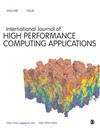Exascale计算项目中应用程序代码使用的软件实现的调查
IF 2.5
3区 计算机科学
Q2 COMPUTER SCIENCE, HARDWARE & ARCHITECTURE
International Journal of High Performance Computing Applications
Pub Date : 2021-06-25
DOI:10.1177/10943420211028940
引用次数: 10
摘要
美国能源部科学办公室和国家核安全局于2016年启动了Exascale计算项目(ECP),为2023年开始交付的Exascale计算机准备与任务相关的应用程序和科学软件。ECP目前支持针对特定应用的24项工作和6个支持共同设计项目。这24个应用程序项目包含62个应用程序代码,它们用C、C++和Fortran三种高级语言实现,并使用22种图形处理单元编程模型的组合。最常见的实现语言是C++,它用于53种不同的应用程序代码。ECP应用程序中最常见的编程模型是CUDA和Kokkos,它们分别用于15和14个应用程序。本文概述了ECP应用程序代码库中使用的编程语言和模型,这些语言和模型将用于在未来的exascale硬件平台上实现性能。本文章由计算机程序翻译,如有差异,请以英文原文为准。
A survey of software implementations used by application codes in the Exascale Computing Project
The US Department of Energy Office of Science and the National Nuclear Security Administration initiated the Exascale Computing Project (ECP) in 2016 to prepare mission-relevant applications and scientific software for the delivery of the exascale computers starting in 2023. The ECP currently supports 24 efforts directed at specific applications and six supporting co-design projects. These 24 application projects contain 62 application codes that are implemented in three high-level languages—C, C++, and Fortran—and use 22 combinations of graphical processing unit programming models. The most common implementation language is C++, which is used in 53 different application codes. The most common programming models across ECP applications are CUDA and Kokkos, which are employed in 15 and 14 applications, respectively. This article provides a survey of the programming languages and models used in the ECP applications codebase that will be used to achieve performance on the future exascale hardware platforms.
求助全文
通过发布文献求助,成功后即可免费获取论文全文。
去求助
来源期刊
CiteScore
6.10
自引率
6.50%
发文量
32
审稿时长
>12 weeks
期刊介绍:
With ever increasing pressure for health services in all countries to meet rising demands, improve their quality and efficiency, and to be more accountable; the need for rigorous research and policy analysis has never been greater. The Journal of Health Services Research & Policy presents the latest scientific research, insightful overviews and reflections on underlying issues, and innovative, thought provoking contributions from leading academics and policy-makers. It provides ideas and hope for solving dilemmas that confront all countries.

 求助内容:
求助内容: 应助结果提醒方式:
应助结果提醒方式:


